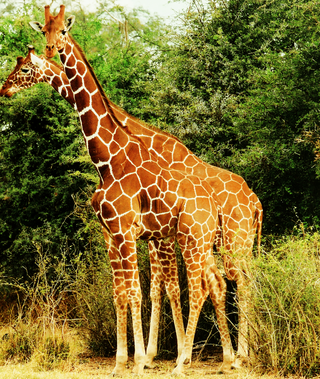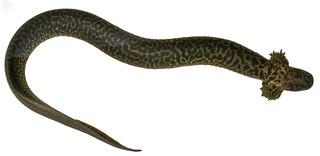Related Research Articles

Amphibians are ectothermic, anamniotic, four-limbed vertebrate animals that constitute the class Amphibia. In its broad sense, It is paraphyletic group encompassing all tetrapods excluding the amniotes. All extant (living) amphibians belong to the monophyletic subclass Lissamphibia, with three living orders: Anura (frogs), Urodela (salamanders), and Gymnophiona (caecilians). Evolved to be mostly semiaquatic, amphibians have adapted to inhabit a wide variety of habitats, with most species living in freshwater, wetland or terrestrial ecosystems. Their life cycle typically starts out as aquatic larvae with gills known as tadpoles, but some species have developed behavioural adaptations to bypass this.

The hellbender, also known as the hellbender salamander, is a species of aquatic giant salamander endemic to the eastern and central United States. It is the largest salamander in North America. A member of the family Cryptobranchidae, the hellbender is the only extant member of the genus Cryptobranchus. Other closely related salamanders in the same family are in the genus Andrias, which contains the Japanese and Chinese giant salamanders. The hellbender, which is much larger than all other salamanders in its geographic range, employs an unusual means of respiration, and fills a particular niche—both as a predator and prey—in its ecosystem, which either it or its ancestors have occupied for around 65 million years. The species is listed as Vulnerable on the IUCN Red List of Threatened Species due to the impacts of disease and widespread habitat loss and degradation throughout much of its range.

Salamanders are a group of amphibians typically characterized by their lizard-like appearance, with slender bodies, blunt snouts, short limbs projecting at right angles to the body, and the presence of a tail in both larvae and adults. All ten extant salamander families are grouped together under the order Urodela from the group Caudata. Salamander diversity is highest in eastern North America, especially in the Appalachian Mountains; most species are found in the Holarctic realm, with some species present in the Neotropical realm.

The reticulated python is a python species native to South and Southeast Asia. It is the world's longest snake, and the third heaviest after the green anaconda and Burmese python. It is listed as least concern on the IUCN Red List because of its wide distribution. In several countries in its range, it is hunted for its skin, for use in traditional medicine, and for sale as pets. Due to this, reticulated pythons are one of the most economically important reptiles worldwide.

Sirenidae, the sirens, are a family of neotenic aquatic salamanders. Family members have very small fore limbs and lack hind limbs altogether. In one species, the skeleton in their fore limbs is made of only cartilage. In contrast to most other salamanders, they have external gills bunched together on the neck in both larval and adult states. Sirens are found only in the Southeastern United States and northern Mexico.

The Oklahoma City Zoo and Botanical Garden is a zoo and botanical garden located in Oklahoma City's Adventure District in northeast Oklahoma City, Oklahoma.

Siren is a genus of aquatic salamanders of the family Sirenidae. The genus consists of three living species, along with one extinct species from the Eocene Epoch and three from the Miocene.

The lesser siren is a species of aquatic salamander native to the eastern United States and northern Mexico. They are referred to by numerous common names, including two-legged eel, dwarf siren, and mud eel. The specific epithet intermedia denotes their intermediate size, between the greater siren, Siren lacertina, and the dwarf sirens, Pseudobranchus species.

The San Antonio Zoo is an Association of Zoos and Aquariums-accredited zoo in Midtown San Antonio, Texas, United States. It is located in the city's Brackenridge Park. San Antonio Zoo is a 50+ acre zoo home to over 750 species, some of which are endangered or extinct in the wild, and an annual attendance of more than 1 million. It also runs non-animal attractions, such as the 2 ft narrow gauge San Antonio Zoo Eagle train ride, which first opened in 1956.

The reticulated giraffe is a species or subspecies of giraffe native to the Horn of Africa. It lives in Somalia, southern Ethiopia, and northern Kenya. There are approximately 8,500 individuals living in the wild.

Robert Cyril Stebbins was an American herpetologist and illustrator known for his field guides and popular books as well as his studies of reptiles and amphibians. His Field Guide to Western Reptiles and Amphibians, first published in 1966, is still considered the definitive reference of its kind, owing to both the quality of the illustrations and the comprehensiveness of the text. A professor of zoology at the University of California, Berkeley, for over 30 years, he was the first curator of herpetology at the Museum of Vertebrate Zoology, a 1949 Guggenheim fellow, and author of over 70 scientific articles. His discovery of the ring species phenomenon in Ensatina salamanders is now a textbook example of speciation, and he performed extensive research on the parietal eye of reptiles. He produced nature films, supported science education in primary grades, and organized conservation efforts that aided in the passing of the 1994 California Desert Protection Act. After retirement he continued to paint, collect field notes, and write books. Stebbins is commemorated in the scientific names of three species: Batrachoseps stebbinsi, the Tehachapi slender salamander; Anniella stebbinsi, a legless lizard; and Ambystoma tigrinum stebbinsi, the endangered Sonora tiger salamander.
Ten Deadliest Snakes with Nigel Marven is a twelve-part wildlife documentary series from 2013 to 2017. It began airing on Eden Channel in 2013. Seasons 1 and 2 were also broadcast on Animal Planet Europe, while season 3 was premiered on Nat Geo Wild UK and later screened on Nat Geo Wild Europe & Africa in 2017. It is presented by Nigel Marven, who travels around the world and in each hour-long episode he counts down his list of ten deadliest snakes in each different country or continent. The series is produced by Image Impact.

Missouri is home to a diversity of flora, fauna and funga. There is a large amount of fresh water present due to the Mississippi River, Missouri River, and Lake of the Ozarks, with numerous smaller rivers, streams, and lakes. North of the Missouri River, the state is primarily rolling hills of the Great Plains, whereas south of the Missouri River, the state is dominated by the oak-hickory Central U.S. hardwood forest.

Florida hosts many types of fauna. From coral reefs of the Florida Keys to the cypress swamps of the Panhandle, the state's diverse habitats are home to a variety of wildlife. Florida is among the top five states in terms of endemic species. There are over 700 terrestrial animals, 200 freshwater fish species, 1,000 marine fish and thousands of terrestrial insects and other invertebrates that inhabit the state. Florida's peninsular geography spans from subtropical to tropical zones, which, combined with its distinctive geology and climate, contribute to habitat diversity and an array of species. The native wildlife that exists in the state are of temperate and tropical origin.

The reticulated siren, also known as the leopard siren or colloquially as the leopard eel, is a species of aquatic salamander in the family Sirenidae. The species, which is endemic to the southeastern United States, was first formally described in 2018. This cryptic salamander is known only from three localities in southern Alabama and the Florida panhandle and is one of the largest animals in the United States to be newly described in the past 100 years.

Karen R. Lips is a Professor of Biology at University of Maryland, College Park. Lips' work in the 1990s eventually contributed to the identification of the chytrid fungus as the primary cause of frog decline worldwide.
References
- 1 2 "Interview with Dr David Steen". thefreethinktank.com. The Freethink Tank. January 19, 2017. Retrieved December 6, 2018.
- 1 2 3 "David A. Steen, Ph.D." Retrieved December 6, 2018.
- ↑ Lund, Nicholas (May 29, 2015). "This Snake Scientist Is the Best Biologist on Twitter". Slate Magazine. Retrieved December 6, 2018.
- ↑ "David Steen, Ph.D. (@AlongsideWild) on Twitter". twitter.com. Retrieved December 6, 2018.
- ↑ Wootson Jr., Cleve R. (May 22, 2018). "He was kayaking in a 'paddler's paradise.' Then, he was bitten by a rattlesnake". Washington Post. Retrieved December 6, 2018.
- ↑ "SciComm Winners". mindlinfoundation.org. The Mindlin Foundation. June 23, 2017. Retrieved December 6, 2017.
- ↑ "Mindlin Science Communication Prize". mindlinfoundation.org. The Mindlin Foundation. June 23, 2017. Retrieved December 6, 2017.
- ↑ Steen, David A. (2019). Secrets of Snakes: the Science Beyond the Myths (First ed.). Texas A&M University Press. p. 184. ISBN 978-1623497972.
- ↑ Graham, Sean P.; Kline, Richard; Steen, David A.; Kelehear, Crystal; Cimmaruta, Roberta (December 5, 2018). "Description of an extant salamander from the Gulf Coastal Plain of North America: The Reticulated Siren, Siren reticulata". PLOS ONE. 13 (12): e0207460. Bibcode:2018PLoSO..1307460G. doi: 10.1371/journal.pone.0207460 . PMC 6281224 . PMID 30517124.
- ↑ Bittel, Jason (December 5, 2018). "New species of giant salamander discovered in Florida". nationalgeographic.com. National Geographic. Archived from the original on December 5, 2018. Retrieved December 5, 2018.
- ↑ Graham, S. P.; Steen, D. "Song of the Siren – The Story Behind How We Found and Described a Two-foot Long Amphibian New to Science". livingalongsidewild.com. Living Alongside Wild. Retrieved December 6, 2018.